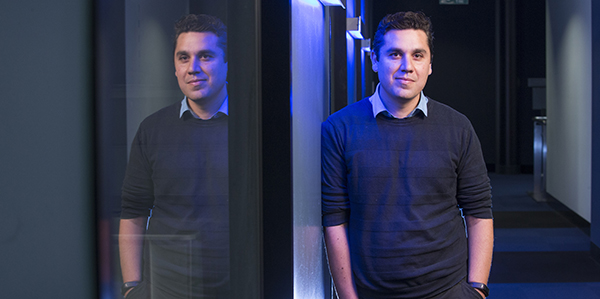1:30min

ANU researcher Dr Riccardo Natoli. Photo, Lannon Harley, ANU.
______________________________
By Helen Carter
Journalist
Australian researchers are developing a blood test to detect patients at risk of developing dry age-related macular degeneration (AMD.)
They hope it will be able to predict people at high risk of the disease so treatment can begin before the disease presents, therefore preventing blindness.
Lead researcher Dr Riccardo Natoli from The John Curtin School of Medical Research and the Australian National University Medical School said it could take years for signs of dry AMD to be found and often by the time it was diagnosed the disease was irreversible.
He is developing a blood test to detect the disease earlier based on a model he has developed.
‘The detection mechanisms we currently have for dry AMD happen too late,’ Dr Natoli said in a media release. ‘Once dry AMD starts there is a threshold tipping point and once a patient gets over that point there is nothing that can be done to save their sight.
‘By the diagnosis stage, you look at the back of the eye and you already see that photoreceptors, the light sensing cells of the eye, are starting to die.’
Researchers used a light model, thought to be the first of its kind, to better understand the deterioration of the retina’s photoreceptor cells in the macular.
Slowing the inflammatory response
‘From our modelling we noticed an inflammatory response was happening as a consequence of the damage,’ Dr Natoli said. ‘We are focusing on early diagnosis and early treatment strategies that slow the inflammatory response to see if we can slow the progression of the disease.’
The research is backed by the ANU’s Translational Fellowship Program and Beta Therapeutics which has teamed with ANU to start testing drugs to slow the inflammatory response.
‘The macular is the part of the retina that helps you see the grooves on your fingerprints. It is only 5.5 mm, so if an area equivalent to the size of a pin head starts dying – it renders you legally blind,” he said. ‘Once that’s lost, there is no repairing it.
‘By looking at these photoreceptor molecules in the macular and understanding how they function, we will be able to predict or diagnose early a patient who is having systemic inflammatory responses.
‘Combined with predisposition genetic information, we hope to be able to predict people who are at high risk and start treating before the disease presentation even eventuates.’
______________________________
Tagged as: AMD, Patient management